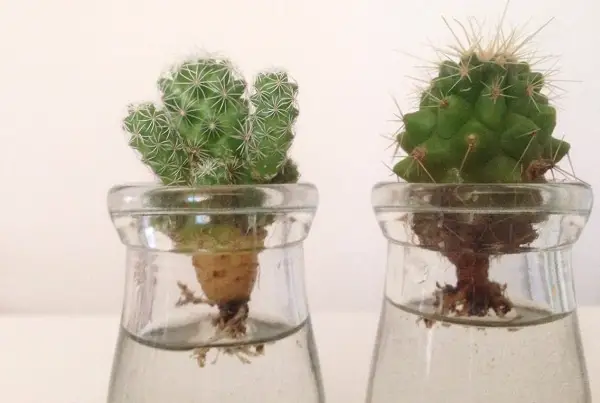Cacti are some of the most amazing plants on earth, surviving where almost nothing else can, retaining more water than most would ever expect, and flowering in some of the most amazing ways ever seen by plants. When you have a few growing on your windowsill, you may wonder how to create more for your own garden and as gifts.
To propagate cacti using water, you need to suspend the open part of the cutting, stem, or leaf in the water, with the water level checked every few days to ensure the growing roots are always touching the water. Once roots start growing or new baby off-shoots start showing up, the cacti have successfully started growing only in water.
The biggest challenge of propagating cacti in water is knowing which cacti will grow easily using this technique. While almost all cacti can be propagated in this manner, some cacti find it more challenging and may prefer other materials or just dirt to be used when being propagated.
Here’s everything you need to know about propagating cacti using only water.
Which Parts of the Cacti are Required?
If you are starting the journey of making your only cacti into a large bundle that loves growing in your yard, you will need to know which part of the cacti to use. What works for the hardiest of cacti might not work for cacti that are used to more lush environments. There are three main parts to all cacti, and identifying which you can use parts of each will save you time and a lot of headaches.
Stem Cuttings
The one that is most likely to work and the only one that is possible to do with every cactus on earth, using the stem of cactus to propagate more is a surefire way of succeeding. The stem often needs to be suspended perfectly in some water, either in a glass bowl or pot, to grow cactus.
One of the fascinating ways that cacti grow in the wild has been observed when an animal accidentally breaks off a piece of the stem and carries it around. Eventually, the stem would fall off, and a new cactus would grow from the broken-off stem.
Roots
Cacti have roots just like every other plant, and like all others, you can use this root to grow more cacti from the parent plant without much challenge. You will often need to use more than plain water, owing to the root needing some help to promote growth as it sucks up the water.
Many people that use roots to propagate cacti prefer to have a few rocks in the water. This gives the root something to hold onto and to stay perfectly suspended in the water easily.
Leaves
The rarest form of propagating in the world of plants, some cacti can grow new plants by simply having a leaf suspended in some water. Some of the best cacti grow using this and knowing which ones can be propagated using this technique.
Most cacti that can be propagated using this technique will be unique in that they have leaves to use for this. These leaves are usually quite sensitive, and thick enough not to dry out when left broken off from their parent plant. Propagating these using water can be simple. Just be sure to remove the cactus before it grows too much.
Grow Cactus From Cuttings In Water
Propagating cactus in water is a simple and effective way to multiply your existing plants. This method can be used with most types of cacti, including barrel, saguaro, prickly pear, and more. The first step involves taking cuttings from the parent plant.
Cut at least two to three inches away from the stem’s base using sterile scissors or pruning shears. Remove any old growth or dead flowers that may still be attached to the cutting. Once the cuttings have been taken, it is important to allow them to dry for several days before placing them into water.
The dried cuttings should then be placed into clean jars filled with room-temperature filtered water so that only the bottom one-third of each cutting is submerged under water. Place the jar in an area where there is indirect sunlight and keep an eye on its progress over time.
Some species will form roots within weeks while others may take months; this depends on both environmental conditions as well as the type of cactus being propagated. When viable root systems are formed, carefully transplant your new baby plants into individual pots filled with potting soil designed for cacti or succulents.
Tools You Need For Propagating Cactus In Water
Propagating cacti in water requires a few tools to ensure success. First, a pair of clean scissors or pruning shears is necessary for cutting the stem and removing any thorns that may be present. These can also be used to cut off dead leaves and flowers from the plant before propagating it.
Second, you will need some sort of container to hold your propagation material as well as the water. This could be anything from an old glass jar or plastic cup to a more specialized vessel such as a terracotta pot with drainage holes drilled into the bottom. It should have enough room for submerging the entire stem of the cactus so that all parts are covered by water.
Finally, you’ll need something to act as support for newly formed roots once they start growing out from the base of the stem. A piece of Styrofoam or even rocks placed at the bottom of your container works great for this purpose so that new rootlets don’t just float away in the current.
Is it Better to Propagate Cacti in Water?
This is one of the most debated questions in the world of cacti, with many growers believing that allowing the plant to grow in sand from the start is much healthier. However, others will only ever propagate using water, preferring to boost their new cactus plants significantly.
For some cacti, it is best to propagate them using water, allowing the plant to have a good boost when it is growing every part of itself. Other cacti must be propagated using sand and rocks, allowing the roots to grow stronger in a simulated environment of their natural world.
Knowing which cacti prefer can be hard, as many variants used inside homes will differ greatly from those growing in the wild. The best way to learn how each cactus prefers to be propagated is to test them out, as the plants tend to grow faster when in the water. This is an easy task to accomplish.
Can Succulents Grow only in Water?
While cacti love being propagated in only water, they cannot grow forever in them, most cacti need solid soil for more than just nutrients to be gathered. As these plants are used to growing either in rocky or sandy terrains, their roots have become unique.
The sun will often damage the root systems once the cacti are returned to a position where they can constantly get sun. This is why it is always important to have your cactus in a pot after it has shown several weeks of growth in only water.
The best cacti usually being potted once the roots reach the bottom of whatever container they may be in. Just be sure that the sand you are using for these pots is correct and not too moist or soft for the cactus to grow efficiently.
How Long Does it Take to Propagate Cacti in Water?
While propagating cacti in the soil can take any given amount of time. Usually, cacti will start growing within 25 days if propagated using water. Sometimes it may even be faster depending on the overall health of the parent plant.
This growth is caused by the nutrients present in water and the plant wanting to find some way to survive once broken off from its parent. Having cacti that grow properly and without trouble will mean that even when they have started growing roots in the water, you will be leaving them in there for a while longer.
For this quick propagation time, many cacti owners are so in love with the plant, allowing them to grow their own garden with absolute ease in only a few weeks.
How Will You Know that is Not Working?
While many cacti can be propagated using this technique, some require more practiced hands. Many of the rarest and largest cacti species have more traditional propagation methods, using flowers and seeds to spread themselves worldwide.
When you are propagating a cactus in the water, there are several signs that you need to look for to know when the cactus is dying instead of growing. The first thing that you will always see is the color change. A properly growing cactus will turn a lot greener, almost seeming to turn the same shade as a dark green grass lawn.
However, the color change of a dying cactus will make it go a lot paler, almost turning white before finally shriveling until the cactus turns into nothing but a husk of its former self. This is the first and most obvious sign that the propagation through water has not been effective.
Conclusion
Propagating cacti through water has always been one of the most popular ways to grow more cacti in your garden. Many growers love having more than just one plant in their collection, and propagating is not always focused on your own plant. Sometimes plant lovers like to exchange plants, and the water propagation way of cacti has made them extremely popular as a trading item.
Just be sure you don’t put the stem of a plastic cactus in the water. That would never grow!


